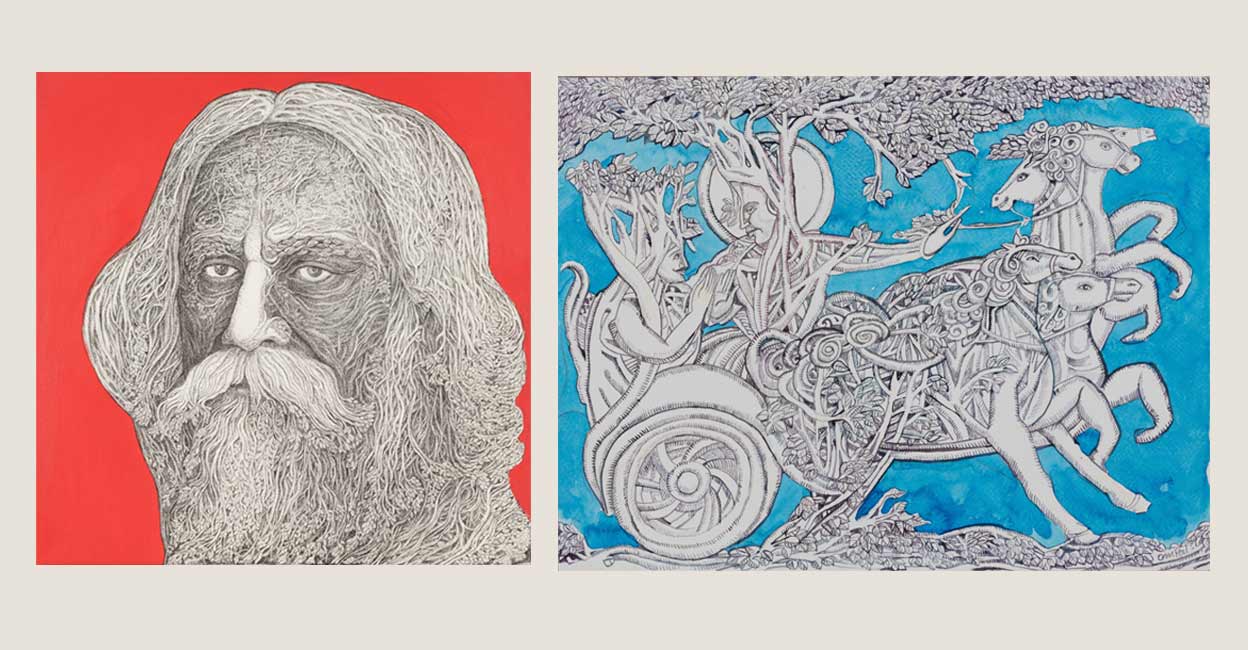How the ‘scary’ peepul became artist Ompal Sansanwal’s muse

Mail This Article
Right from childhood, Ompal Sansanwal found joy in watching trees at the garden behind the house. Particularly fascinating was the banyan with its shivering leaves. Growing up in south Delhi, a particular peepul in his locality of Katwaria Sarai got etched in the boy’s deep consciousness. As Ompal grew up to become an artist, the image of that bodhi tree began finding expression in all his paintings.
Adding surrealism to his impression about trees was a spooky episode from the youthful times of Ompal, now 60. That old peepul was one which local people believed was “inhabited by ghosts”, he recalls, amid an exhibition of his artworks that is on in the national capital. “People would avoid going past that tree at night. I was scared too. While returning home late at night from the Delhi Art College, I had to either go past the peepul or, out of fear, walk an extra mile along another route.”
Not surprising, thus, that the ageing and eerie peepul functions as an abiding inspiration for Ompal. Its dark hollow trunk and rustling foliage has been central to a set of 60 of Ompal’s intricate paintings on trees at the Jiva show concluding this week. What’s more, each tree tells a different story for the visitors at Bikaner House near India Gate. Presented by Black Cube Gallery, the April 27-May 3 event has been curated by noted art historian and scholar Uma Nair.
At ‘Jiva’, which has been drawing impressive attendance, Ompal’s paintings abound in the peepul. The tree’s labyrinthine roots and spreading branches find unearthly portrayal in acrylic-and-pen and ink-on-canvas.
So, is it fear kindling Ompal’s artistic spirit at ‘Jiva’? Not at all, if you go by the entire anecdote. “One night, as a youngster, I thought I must settle the matter. I stood in front of the tree, and spoke aloud to it: ‘‘Come, show me your ghost!’ I shouted,” he reminisces. “I did hear a flapping sound and got yet another feel of shadowy forms moving. But that’s just an image from the fluttering leaves. At this, my fear went away.”
Ompal went on to paint the peepul, and won an all-India award for the work titled ‘Nature’. Since then, that tree has been the basis for his art, finding “its way into all my paintings”. And ‘Jiva’ comes after a break of one-and-a-half decades even as the peepul and banyan had become his muses of study at the art-college campus. “The sight of a banyan will pop inside me a human form. I can spot trees that walk and even dance.”
And Ompal has brought this into his works. Two eyes, a nose and a mouth emerge from amid the thick foliage and densely entangling roots in some of his intricately painted works on display (untitled 18x18”, and 28x22”). Or the tree leaves and roots weave together to take the shape of a horse’s head (untitled 28x22”) ; or the banyan tree’s many roots sinuously curve together to seem as they are dancing with arms raised (28x22”), or even two trees are locked in an embrace (12x15”).
Curator Uma Nair notes that Ompal crafts delicate renderings that evoke the profound interconnection between humanity and nature. “His reverence for the banyan tree underscores his belief in nature as sanctified, eternal and sublime.”
The vivid colours of the background make his pen and ink drawings of the trees stand out with its minute, intricate details of the leaves and roots -drawing the viewer into the depths of the labyrinthine maze. In a tree, Ompal also sees a “story”.

His painting of Rabindranath Tagore (16x16”) is striking for the way the long, winding roots and leaves merge together to create the well-known visage of the poet laureate, with his beard and long hair. One of his larger works, an 8 feet X 20 feet untitled work comprising five panels of 8x4 feet, is of a forest done in ochre tones. This particular one is representative of the ‘baghichi ‘ (garden) Ompal loved playing as a child.
Mythology, too, has influenced Ompal. His childhood memories of watching the Ramlila and Krishna Leela show up in his paintings. His paintings of Krishna holding aloft the Govardhan hill, sheltering the people of Mathura and the cows (2x3 feet), Shiva as Nataraj (6x6 feet) or Krishna playing the flute as the cows follow behind (4x5 feet), or the Pandavas and Kauravas facing off during the Kurukshetra battle (5x15 feet) — all comprise trees, with their long, curling roots and leaves, telling the stories.
Ompal won the Lalit Kala Akademi National Award for painting in 2002 and the 1991 All India Award by the Rajasthan Lalit Kala Academy. His works have been featured in several solo exhibitions, including at Mumbai’s Museum Gallery and Delhi’s LTG and Shridharani, besides in group shows held at the Nehru Center in London, and in Yugoslavia.
Jiva is open to the public from 11 a.m. to 7 p.m.

